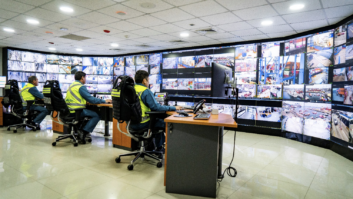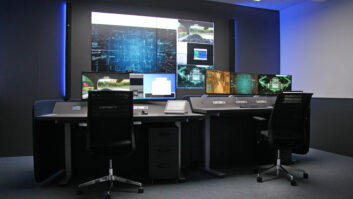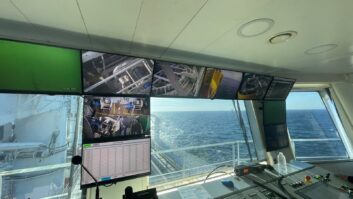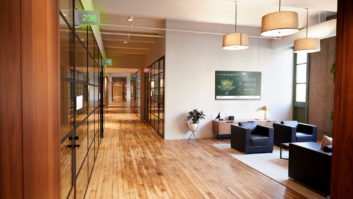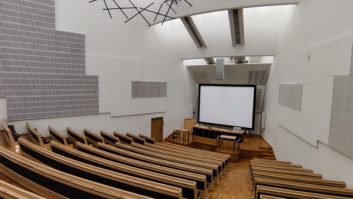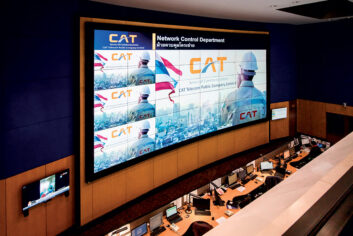
The frequency with which control rooms have put cutting edge technologies to the test – from UHD resolution video to complex IP infrastructures – has been repeatedly reinforced in Installation over the years. This latest overview is no exception, but what makes it more exceptional this time around is that it comes after a period of sustained challenges – not necessarily to do with demand, which has remained strong, but around persistent supply chain problems that transcend industries.
Joe da Silva, vice-president of marketing for Extron, remarks: “From our perspective, the demand for these spaces has remained strong, and in some markets such as healthcare and government services it has increased. What has been impacted is a manufacturer’s ability to deliver the products to meet demand. Extron’s command and control room offerings have continued to be accessible, despite the turbulence of the past few years.”
Jochen Bauer, director of sales at Guntermann & Drunck (G&D), says: “The pandemic and the supply chain have caused some problems concerning the procurement of complementary products. This led to some delays and there is currently a catch-up effect we are dealing with. Still, we are optimistic about the future and are receiving inquiries for major projects.”
The general tone here of ‘optimism despite challenges’ is indicative of a market that appears to be thrumming with activity as we enter the second half of 2023. Contributors to this article variously alluded to projects in the energy industry, maritime & air traffic control, industrial facilities, broadcast centres and other ‘mission-critical’ environments. Technology-wise, IP continues to be a driving force behind many new projects, while the latest visual display technologies are also doing well in this space. Inevitably in a world where cybercrime is continuing to increase, security is another top priority.
Tech fundamentals
Some technological fundamentals remain unaltered, and in the control room environment none are more integral than KVM (keyboard, video, mouse) solutions that can be employed to connect multiple users to many different computers. With the possibility of connecting users in multiple locations, potentially around the world, KVM solutions are often designed to support effective real-time control and collaboration. While there continues to be a demand for point-to-point KVM products that extend keyboard and mouse functionality, recent years have seen a sharp increase in demand for KVM-over-IP that delivers network availability of multiple computer sources.
“KVM systems are often the backbone of the infrastructures,” says Bauer, who alludes to an ongoing focus at G&D on solutions for implementing redundancy. “New to the portfolio is an additional feature for securing an overall installation in KVM-over-IP environments called DirectRedundancyShield, which guarantees a fully redundant and failsafe infrastructure.”
The principles of KVM also resonate with an increased industry-wide emphasis on energy reduction. Bauer notes: “KVM ensures that control rooms can be operated more energy efficiently. By outsourcing technology from workspaces, KVM not only improves noise in the working environment of control rooms, but also reduces the development of heat. With our PersonalWorkplace-Controller, multiple sources can be arranged on just one monitor. [In addition] G&D products are extremely durable with a long product lifecycle.”
For Extron, da Silva indicates that supporting technologies and requirements have changed while “conceptually, the purpose of these rooms has remained the same”. The company has offered “traditional USB extension, and keyboard and mouse switching for many years; we then added that functionality to our fibre matrix switchers and endpoints. Our current FOX3 [fibre optic distribution solution] with the optional LinkLicense for KVM System Configuration and Control enables a user at a workstation to control up to four remote computers with a single keyboard and mouse. A key development is the SmartGlide KVM Switching feature that provides automatic, fast and seamless keyboard and mouse switching as the mouse glides from one workstation display to the next.”
Converging standards
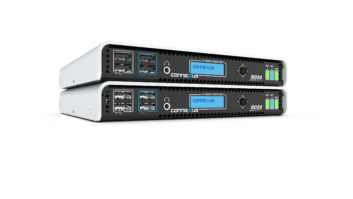
InfoComm 2023 saw Ross Video launch its first KVM matrix solution, Connexus, which is described as providing a ‘true’ hybrid 2K/4K KVM endpoint and an intuitive enterprise-level KVM management system. Most synonymous with the broadcast world – where its production switchers, video servers and replay systems are commonly found – the company has long had a presence in the control room space, but acknowledges that there is now a burgeoning convergence between broadcast- and AV-style applications.
Ahead of the recent show, Ross Video senior vice-president vertical markets and solutions Jared Schatz said that its involvement in the Orlando gathering underlined its “growing focus on the AV industry. Our aim is to blur the lines from broadcast to AV, making the technology more accessible for a variety of industries. We are empowering our clients to navigate complex broadcast solutions more efficiently.”
To this end, InfoComm also saw Ross showcase its new Quorum meeting control solution – designed to provide government, legislators and corporations with ‘broadcast-quality’ production, automated multi-camera tracking, professional-looking graphics and intuitive touch controls – and D3 LED display solutions that offer advanced features such as colour calibration, image processing and remote management.
Lightware Visual Engineering is another company to be tackling broadcast-AV convergence, including in more broadcast-oriented environments. CEO Gergely Vida remarks: “Control rooms are the nerve centre of broadcast and media operations, encompassing television studios, radio stations and live event production. Offering advanced pro-AV room equipment, including matrix switchers, [has brought] success in this sector for us. The increasing demand for high-quality content production and live streaming has further driven the growth of this market segment. We are proud that the solutions and devices of Lightware contributed to the success of the Eurovision Song Contest 2017, the Olympic Games, and the Expo 2020 in Dubai – just to mention a few world-class broadcast events.”
The blending of increasingly powerful control systems with evolving display technologies is a recurring theme for vendors in this space, and VuWall is no exception. CEO & founder Paul Vander Plaetse recalls: “The control room market is rapidly evolving, where operators are dealing with fast-paced changes due to volatile macroeconomic and geo-political factors. In recent years, we have observed a growing need for operators to have more autonomy in how they use their control rooms. Previously, system integrators configured the different work presets based on their pre-established processes.
“Today, they must adjust their work scenarios and processes so often that they demand systems that they can configure themselves, at a moment’s notice, without any programming. VuWall’s solution designs and development prioritise the ability to quickly and easily operate and reconfigure presets. [In addition] as display technology has become more affordable resulting in a significant increase in the number of control rooms being built, especially small to medium size control rooms, VuWall solutions are designed to be scalable in order to accommodate control rooms of any size.”
The second part of this feature is available to read here.
